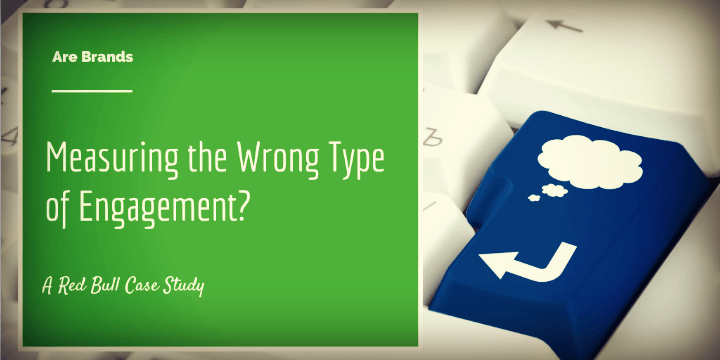
Most brands consider engagement a KPI (key performance indicator) to their digital marketing success. Regardless of the size or industry of the business, everyone wants more engagement in the form of blog comments, social media comments, social shares, etc. There is no doubt engagement is a valuable metric.
Except we’re measuring the wrong type of engagement.
As the online and offline world converge through an increasingly competent semantic web, focusing on inbound engagement is only half the story. Brands are grasping for content to attract attention and ultimately engagement from customers and prospects.
Attracting attention with content is neither a cheap nor easy task in the noisy online world.
Even one of the world’s best content creators isn’t focused on outbound engagement.
I like to follow Red Bull’s social media activity. Partly because the action sports content they share is amazing and partly because it astounds me how much engagement they leave on the table by NOT dipping back into their social media posts.
Red Bull gets an A++ for creating visually astounding content around captivating events and stories, but an F when it comes to engagement.
They receive 18 replies and don’t respond to one of them. The Tweet did receive 69 retweets and 230 favorites which seems like a lot. Until you find an average of 158 retweets for the ten posts after this one.
How much further could this conversation have gone if the Red Bull’s Twitter account had dipped back into the conversation and facilitated a flavor debate?
Visually, the thumbnail and video are stunning and the share counts are outrageous. But 172 comments without a single response from the Red Bull account or a community manager, leaves additional reach and brand equity on the table.
Further examination shows the same absence of follow-up brand engagement on blog comments, Google+ and YouTube.
What if instead of focusing on inbound engagement, our metric was outbound brand engagement?
Outbound Brand Engagement
Most brands don’t have the capability to create the media that Red Bull does. Please understand, this isn’t a knock on Red Bull as a media company.
Just an idea, for one simple tweak in their social media strategy, which could take their reach to a whole nother level.
Instead of flailing at KPIs we have indirect control over, such as Likes, Tweets and +1s, why not focus on a metric we drive through our own actions every single day?
[pullquote]New KPI = Outbound Brand Engagement[/pullquote]
Outbound brand engagement.
Customers want more of us, not just our latest YouTube video or advertorial blog post, but also the personality behind the brand. Today’s digital consumer wants authenticity, transparency, and honesty. Abstract terms for sure, but also the building blocks of brand loyalty and trust.
Red Bull bakes these characteristics into their media through first person views of stunts the vast majority of people would never consider attempting. Sitting on an innertube and using a bungee cord to launch yourself 30 feet into the air, to hopefully land in a lake is nothing but authentic, transparent, and honest.
These attributes come naturally to Red Bull and because this, they’re able to get away with zero outbound engagement.
For most brands this is not the case.
I can only imagine how far that message would go if Red Bull was dipping back into the stream to answer audience questions about a particular stunt or event. Even more electrifying would be the athletes who performed the stunts answering questions.
Instead of filling consumer news feeds with more of same content, brands must begin reaching out and engaging one person at a time.
Conclusion
Here’s the beauty of this strategy: With social media we’re never talking to just one person.
Each engagement is a new piece of public content.
Nothing pulls customers into your brand like the perception of a personal relationship. There is no better way to build that perception than connecting with individuals directly. Responding to even 5% of the comments you receive across your social media properties creates the perception of greater engagement.
Engagement builds trust, trust builds loyalty, and brand loyalty leads to more sales.
How does your brand engage with your social media audience?
Featured image created by author.






